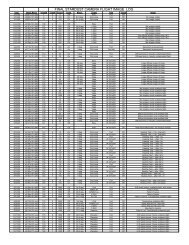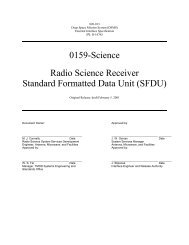PDS_VERSION_ID= PDS3 - PDS Small Bodies Node
PDS_VERSION_ID= PDS3 - PDS Small Bodies Node
PDS_VERSION_ID= PDS3 - PDS Small Bodies Node
You also want an ePaper? Increase the reach of your titles
YUMPU automatically turns print PDFs into web optimized ePapers that Google loves.
PHASE_ANGLE<br />
The PHASE_ANGLE element provides a measure of the relationship between the<br />
instrument viewing position and incident illumination (such as solar light).<br />
PHASE_ANGLE is measured at the target; it is the angle between a vector to the<br />
illumination source and a vector to the instrument. If not specified, the target is<br />
assumed to be at the center of the instrument field of view. If illumination is from<br />
behind the instrument, the PHASE_ANGLE will be small.<br />
RECORD_FORMAT<br />
The RECORD_FORMAT element contains a FORTRAN-style format description<br />
for reading an entire row of an ASCII/EBCDIC table, or an entire occurrence of<br />
an ASCII/EBCDIC COLLECTION<br />
^HEADER<br />
The HEADER object is used to identify and define the attributes of commonly<br />
used header data structures for non-<strong>PDS</strong> formats such as VICAR or FITS. These<br />
structures are usually system or software specific and are described in detail in a<br />
referenced description text file. The use of bytes within the header object refers to<br />
the number of bytes for the entire header, not a single record.<br />
^IMAGE<br />
An IMAGE object is a regular array of sample values. Image objects are normally<br />
processed with special display tools to produce a visual representation of the<br />
sample values. This is done by assigning brightness levels or display colors to the<br />
various sample values. Images are composed of LINES and SAMPLES. They<br />
may contain multiple bands, in one of several storage orders.<br />
Note: Additional engineering values may be prepended or appended to each LINE<br />
of an image, and are stored as concatenated TABLE objects, which must be<br />
named LINE_PREFIX and LINE_SUFFIX. IMAGE objects may be associated<br />
with other objects, including HISTOGRAMs, PALETTEs, HISTORY, and<br />
TABLEs which contain statistics, display parameters, engineering values, or other<br />
ancillary data.<br />
ROWS<br />
The ROWS element represents the number of rows in a data object.<br />
ROW_BYTES<br />
The ROW_BYTES element represents the maximum number of bytes in each<br />
data object row.<br />
COLUMNS<br />
The COLUMNS element represents the number of columns in each row of a data<br />
object.






